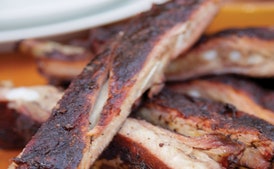
Introduction
Grilled Peppered Dry Spareribs are a flavorful and hearty dish that combines the smokiness of grilling with a unique blend of spices. This recipe brings together robust ingredients to create an irresistible main course, perfect for gatherings or as a satisfying meal on its own. The infusion of lemon pepper and Cajun seasoning provides a zesty kick that complements the savory flavor of the spareribs, making it an ideal dish to elevate your dinner table experience with both taste and texture variety.
Tips for this recipe
To achieve the perfect balance in Grilled Peppered Dry Spareribs: ensure that you select high-quality spareribs, preferably from a local butcher. Before grilling, pat dry any excess moisture to promote better caramelization and flavor absorption. Marinate the ribs for at least 30 minutes to let the spices penetrate deeply into the meat. Lastly, maintain a medium heat on your grill to cook the ribs evenly without charring them too quickly.
Why you will love this recipe
Enthusiasts of rich and complex flavors will find Grilled Peppered Dry Spareribs irresinasively delightful. The unique blend of spices not only creates an aromatic experience but also provides a healthier alternative to traditional rib recipes, with leaner cuts that are free from added sugars or unhealthy fats found in some other preparations. This dish is sure to please even the most discerning palates and becomes the centerpiece of any celebration.
Ingredients
– 1/4 cup white cane sugar
– 2 tablespoons lemon pepper
– 1 tablespoon onion salt
– 2 teaspoons celery salt
– 1 seasoned salt
– 1 tablespoon paprika
– 2 teaspoons Cajun seasoning
– 1 teaspoon freshly ground black pepper
– 1 teaspoon ground coriander
– 1/2 teaspoon citric acid
– 2 slabs spareribs
Adviced equipments
– Grill with grate and heat management
– Prep tools (knife, cutting board, measuring spoons)
– Basting brush for coating ribs with apple juice
– Serving platter or dishware
History of the recipe
The journey of Grilled Peppered Dry Spareribs takes us through a rich tapestry of culinary evolution, blending traditional cooking methods with modern flavor experimentation. While not explicitly tied to Canada’s public health nutrition and food policy history, this dish exemplifies the importance of accessible ingredients in creating nourishing meals that can be enjoyed by diverse communities across the nation. It reflects a broader narrative where culinary innovations often occur alongside advances in food accessibility and policy initiatives aimed at improving public health through nutrition.
Fun facts about the recipe
Did you know that spareribs, derived from pork’s rib section, have been a beloved staple in many cuisines around the world? Their robust flavor profile makes them ideal for absorbing complex seasoning blends. Moreover, Grilled Peppered Dry Spareribs can be easily customized with alternative ingredients to cater to various dietary preferences, aligning well with current trends in food inclusivity and health-conscious cooking.
This dish offers a perfect balance of tradition and innovation, making it a crowd-pleaser while also nodding to the ongoing evolution of food policy and nutrition. Its creation reflects how recipes can be both culinary artworks and narratives about our society’s relationship with food and health.



